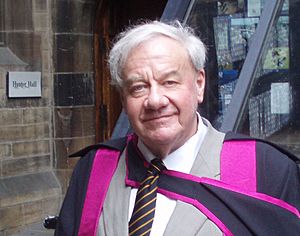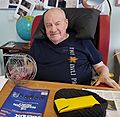Ronald Drever facts for kids
Quick facts for kids
Ron Drever
|
|
|---|---|

Drever in Glasgow 2007
|
|
| Born |
Ronald William Prest Drever
26 October 1931 Bishopton, Renfrewshire, Scotland, UK
|
| Died | 7 March 2017 (aged 85) Edinburgh, Scotland, UK
|
| Nationality | British |
| Citizenship | British |
| Alma mater | University of Glasgow (PhD) |
| Known for | Laser stabilizing technique Pioneering laser interferometric gravitational wave observation. |
| Awards |
|
| Scientific career | |
| Fields | Physics, Laser physics, Experimental Gravitation |
| Institutions | California Institute of Technology, University of Glasgow |
| Thesis | Studies of orbital electron capture using proportional counters (1959) |
Ronald William Prest Drever (born October 26, 1931 – died March 7, 2017) was a Scottish scientist. He was an expert in experimental physics. He taught at the California Institute of Technology (Caltech).
Drever helped start the LIGO project. LIGO stands for Laser Interferometer Gravitational-Wave Observatory. It is a huge science experiment. He also helped invent special ways to make lasers stable. This work was very important. It led to the first time scientists ever detected gravitational waves. This amazing discovery happened in September 2015.
Sadly, Drever passed away in 2017. He was 85 years old. Seven months later, his colleagues Rainer Weiss, Kip Thorne, and Barry Barish won the Nobel Prize in Physics. They won for their work on gravitational waves. Many people believe that Drever would have shared the Nobel Prize with them if he had still been alive. He had already shared many other big physics awards with Weiss and Thorne in 2016.
Contents
Becoming a Scientist
Drever went to school at Glasgow Academy. Then, he studied at the University of Glasgow. He earned his first degree in 1953. In 1959, he completed his PhD. His research was about how electrons are captured inside atoms. He used special tools called proportional counters for this.
Discovering Gravitational Waves
After getting his PhD, Drever started a project in Glasgow. He wanted to find a way to detect gravitational waves. These are ripples in space and time. Albert Einstein first predicted them. In 1970, Drever created the first research group in Glasgow focused on these waves.
That same year, Drever was asked to join Caltech. He helped start a similar program there. In 1984, he moved to Caltech full-time.
Drever's ideas were key to building the LIGO detectors. These detectors are like giant rulers. They are incredibly sensitive. They can measure tiny changes caused by gravitational waves. His work made it possible for LIGO to be sensitive enough. It could detect changes as small as one part in a million billion billion!
His last project involved special tables. These tables floated using magnets. This helped protect sensitive equipment from tiny ground shakes.
Awards and Recognition
Drever received many important awards for his work. These include:
- He became a member of the American Physical Society in 1998.
- He joined the American Academy of Arts and Sciences in 2002.
- He shared the Einstein Prize with Rainer Weiss in 2007.
- He won the Special Breakthrough Prize in Fundamental Physics in 2016.
- He received the Gruber Prize in Cosmology in 2016.
- He shared the Shaw Prize with Kip Thorne and Rainer Weiss in 2016.
- He won the Kavli Prize in Astrophysics in 2016.
- He also received the Smithsonian, American Ingenuity Award in 2016.
- He was given the Harvey Prize in 2016.
- He became a member of the Norwegian Academy of Science and Letters.
Images for kids




